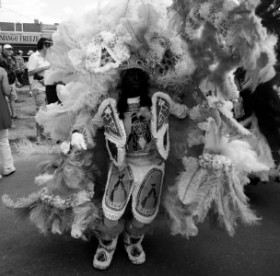
Mary in all her feathered glory. Photo by Savannah Stevens
Meeting Mary
During our class visit to Jackson Square, I met Mary. She was dressed in a beautiful yellow-feathered headdress. The unbelievable and intricate beaded design went throughout her whole costume. Her ensemble was comprised of silver beads, feathers, and colorful fabric. It looked as if these elaborate and detailed hand-made patterns had been manufactured, however, she had actually sewn the costume herself with a needle and thread. Throughout the whole entire year, she put together this costume that was now on display. With that being said, each year she would have a new costume. This tradition, she explained, dated back to times of slavery, and her great, great grandfather had been a Mardi Gras Indian as well.
Mary didn’t seem to have much emotion and she did not speak much; it was as if she was letting the costume speak for itself. It was without a doubt that she was a Mardi Gras Indian. Others, (tourists I assumed), had noticed Mary, and would take pictures of her as they walked by. She would try and stop them, and ask if they wanted to take a picture with her, hoping they would give her money. Being in the heart of Jackson Square, there were many people and tourists buzzing around, despite the overcast and relatively cold weather. Mary didn’t really interact with any of the other artists in the square. As a Mardi Gras Indian in this space that breeds creativity, it was as if Mary was isolated from the other artists in a sense. In the square and streets around it, there appeared to be camaraderie between the artists. They are often displaying their paintings and art pieces side by side one another. However, Mary did not seem to be a part of this. She was on her own and it was almost as if she was just a statue to be gazed at.
Tradition
Mary grew up with the Mardi Gras Indian tradition. Ever since she was a little girl, she remembered beading costumes with her cousins, parents, grandparents, and her whole family. She described how it became something that brought everyone in her family together. Sewing the costumes became a craft that she mastered and dedicated a lot of her time to, because that is what her parents and grandparents did. Every year, Mary always looked forward to getting to march in the different parades. “When we march, it’s a time to just be happy, dance around, let loose. There be some competition going on between the different tribes, ya heard me, but it really is a time where we just get to have fun”. The biggest parade, she described, was on St. Joseph’s day, or “Super Sunday” as it is known most famously. Now, as she is in her 30s, Mary still continues this tradition that is so deep in her roots and culture. The Mardi Gras Indian culture in New Orleans is very prominent within the African-American culture here. “I do it because this is my culture, my heritage. We gotta keep the tradition alive, you heard me?” (“Mary” interviewed by Savanna Stevens, Jackson Square, March 17th, 2014). Mary’s husband is also a Mardi Gras Indian and they still continue to make costumes each year.
New Orleans Tradition as Commodity
While Mary’s year long commitment to the Mardi Gras culture and tradition is a driving force in her work, it is interesting to consider how this tradition is commodified. Mary does not get paid for her labor and participation whatsoever during the year. All of the parades and cultural Mardi Gras Indian traditions are for recreation. When I asked her what she did for a living when she was not out in her Mardi Gras Indian costume, all she shared with me was that she was self-employed. The income she gets towards being in Jackson Square is not much. At most, someone would put a dollar or two in the bucket. However, the compensation she does get from the white change bucket she had does go towards materials for her costume. That change, coupled with her own money funds her expenses. With that being said, Mary is reliant on tourists and their desire to experience and see “real” and “authentic” New Orleans culture. As Mary mentioned, her goal is to keep the Mardi Gras tradition alive. What can then be questioned is whether or not standing in Jackson Square and taking photos with tourists is really teaching them anything. It is important for Mary and the Mardi Gras Indians to have a presence, as it is very easy to often to lose sight of this heritage that has existed in New Orleans for hundreds of years. As a Mardi Gras Indian, Mary’s work is more for personal and cultural pleasure. Yes, the money she gets standing in Jackson square helps her financially, but it is very minimal and does not go towards any other expenses but her work as a Mardi Gras Indian. The connection to her creative work itself and participating in the parades with her family (beyond just in the quarter for tourists) is what keeps Mary doing the creative work that she does.





